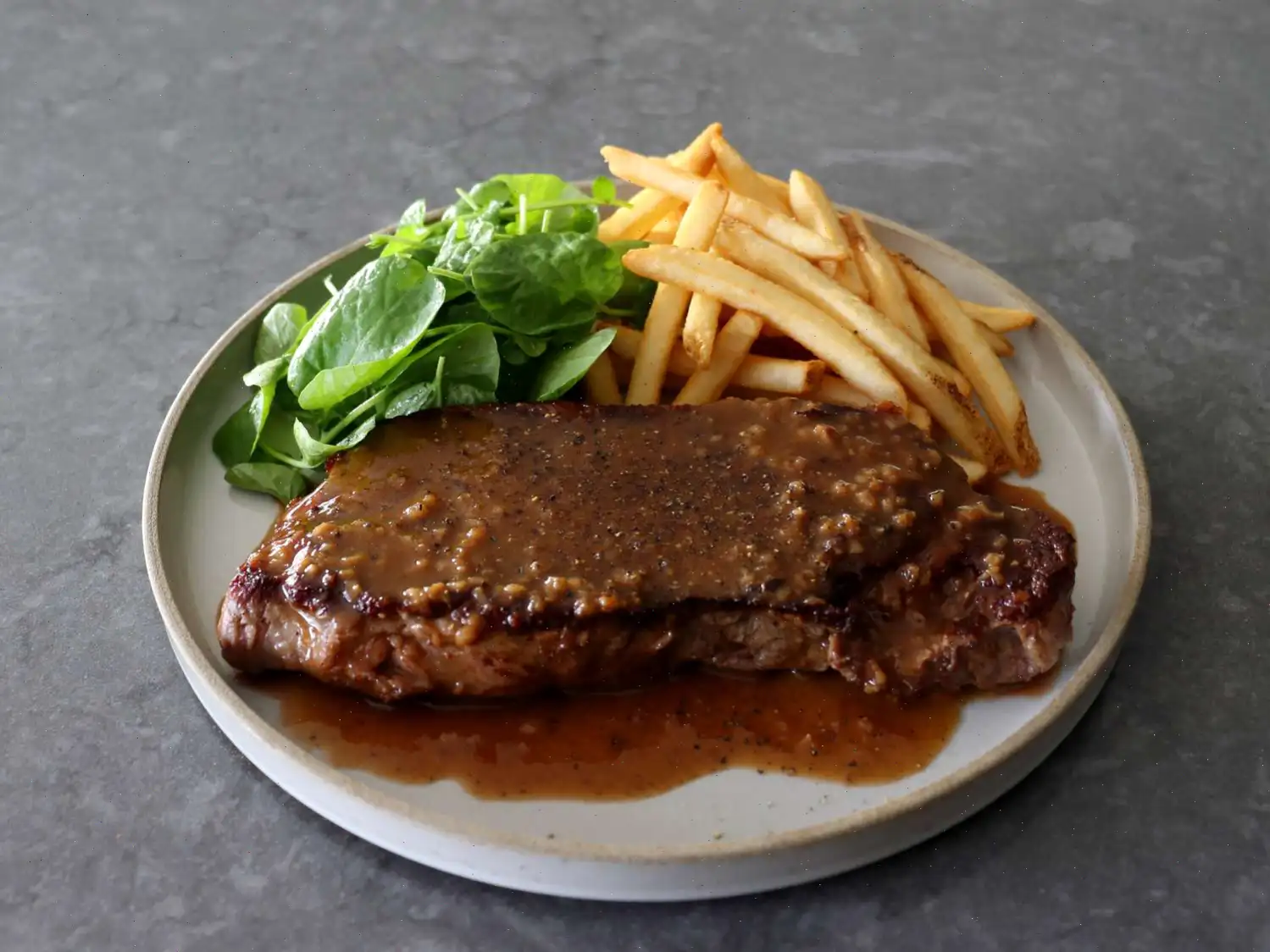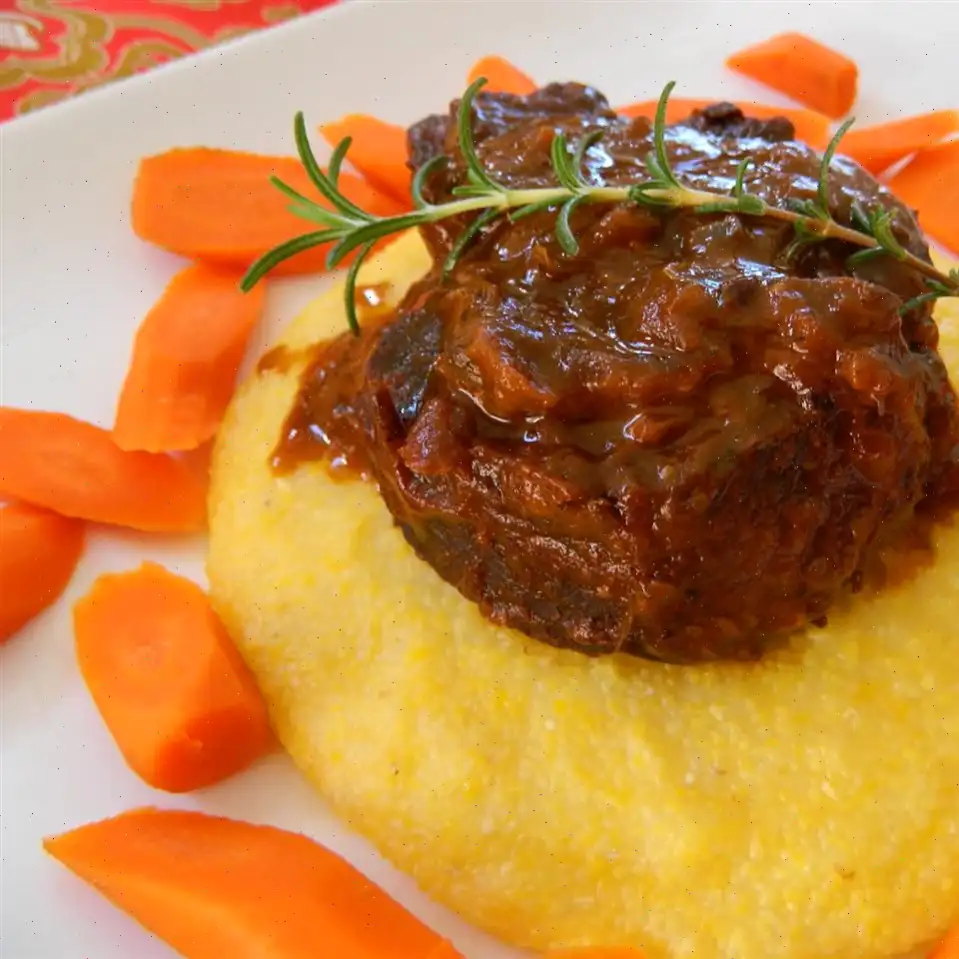
Bistro-Style Steak Recipe
Ingredients
- 1 (14-ounce) New York strip steak
- 3/4 teaspoon kosher salt
- 1/2 teaspoon freshly ground black pepper
- 1 teaspoon vegetable oil
- 1 teaspoon melted clarified butter
- 2 tablespoons minced shallots
- 1/3 cup white wine
- 1/3 cup beef bone broth
- 2 tablespoons unsalted butter, cubed
Directions
- Trim any excess fat from the steak, then use a sharp knife to remove the tough membrane under the fat cap.
- Season the steak evenly on both sides with salt and pepper, and place it on a crinkled-up piece of foil on a plate.
- Refrigerate the steak, uncovered, for at least 2 hours and up to 10 hours. Turn it occasionally to ensure even seasoning.
- Before cooking, let the steak sit at room temperature for 15 to 30 minutes, flipping halfway through.
- Heat a heavy-duty steel pan over high heat. Add the vegetable oil and clarified butter. Once the fats shimmer, place the steak in the pan.
- When the steak begins to sizzle, reduce the heat to medium. Sear the first side for 2 minutes, then use tongs to rub the seared surface around the pan to redistribute the fat.
- Continue to sear for another 2 minutes for a total of 4 minutes. Flip the steak and repeat the process on the second side for 4 minutes or until the steak reaches your desired doneness.
- For medium-rare, remove the steak when the internal temperature reaches 125F (52C). Turn off the heat, remove the steak from the pan, cover loosely with foil, and let it rest for about 5 minutes.
- In the same pan, add minced shallots and stir until they soften and take on some color, about 1 minute. If necessary, turn the heat back to medium.
- Add the white wine and cook, stirring, until the wine reduces by half, about 1 to 2 minutes.
- Pour in the beef bone broth and cook until the liquid reduces by about three-quarters, another 1 to 2 minutes.
- Turn off the heat, add the cold butter cubes, and swirl the pan until the butter melts and a glossy sauce forms, about 30 seconds.
- Season with a pinch of salt if needed, and serve the sauce over the rested steak.
Chef's Notes
- You can use any tender cut of steak with a similar thickness for this recipe.
- Garlic or onion can be used in place of shallots for an alternative flavor.
- For a different taste, substitute red wine for white wine, though white tends to offer a lighter flavor.
- If you prefer, substitute a tablespoon of wine vinegar mixed with 1/4 cup water in place of wine.
Nutrition Facts (per serving)
| Nutrient | Amount | % Daily Value* |
|---|---|---|
| Calories | 800 | |
| Total Fat | 60g | 77% |
| Saturated Fat | 26g | 132% |
| Cholesterol | 193mg | 64% |
| Sodium | 827mg | 36% |
| Total Carbohydrate | 3g | 1% |
| Dietary Fiber | 0g | 2% |
| Total Sugars | 1g | |
| Protein | 53g | 105% |
| Vitamin C | 1mg | 1% |
| Calcium | 35mg | 3% |
| Iron | 5mg | 27% |
| Potassium | 806mg | 17% |
* Percent Daily Values are based on a 2,000 calorie diet. Your daily values may be higher or lower depending on your calorie needs.
The Story Behind Bistro-Style Steak
Bistro-style steak, often referred to as "steak frites" in France, has its roots in the casual eateries of Paris in the 19th century. Bistros were small, family-run establishments where working-class Parisians could enjoy hearty meals at reasonable prices. The concept emphasized simplicity, quality ingredients, and quick service, making it perfect for a perfectly seared steak paired with crisp fries. Over time, this dish became a symbol of French culinary tradition, blending rustic charm with refined cooking techniques.
Regional Characteristics
Though commonly associated with Parisian cuisine, bistro-style steak has regional variations throughout France. In Lyon, for example, it may be served with a rich, wine-based sauce reflecting the region's strong culinary reputation. In Normandy, chefs often incorporate local dairy products, such as butter and cream, to enrich the pan sauce. The cut of meat can also vary; while the New York strip is popular internationally, French bistros may favor entrecte or filet mignon, depending on local preferences and availability.
How It Differs from Similar Dishes
Bistro-style steak distinguishes itself from other steak preparations through its method and accompaniments. Unlike grilled or broiled steaks, this recipe emphasizes pan-searing with clarified butter and a pan sauce made from shallots, wine, and beef broth. Compared to steak au poivre, which uses a peppercorn crust and cream sauce, bistro-style steak focuses on a lighter, glossy sauce that highlights the natural flavor of the meat without overwhelming it. Its also simpler than a cte de boeuf or T-bone preparation, which are typically roasted or grilled for larger servings.
Where It Is Typically Served
Bistro-style steak is a staple of casual French bistros, but it has also made its way into fine-dining establishments around the world. In Paris, it is often enjoyed with a side of pommes frites and a crisp salad. Internationally, you might find it served in gastropubs, contemporary restaurants, or even at home dinners that aim to recreate a classic French bistro experience. Its versatility and elegant presentation make it suitable for both informal and special occasions.
Interesting Facts
- The term "bistro" is believed to have originated from Russian soldiers in Paris who shouted "bystro" (quickly) to request faster service during the early 19th century.
- Traditionally, the pan sauce is finished with cold butter to create a glossy emulsion that enhances both flavor and texture.
- Bistro-style steak recipes often encourage resting the meat after cooking, a technique that preserves juices and ensures a tender bite.
- Despite its simplicity, mastering the perfect sear and sauce can elevate a home-cooked meal to a professional standard.
- The dish is celebrated not only for taste but also for its connection to French culture, embodying the balance of rustic charm and culinary refinement.
You can listen to this recipe in AI audio format. Simply click the play button below to listen to the content in a format that suits you best. It’s a great way to absorb information on the go!
FAQ about Bistro-Style Steak Recipe
Comments
Heather Roberts
07/31/2023 09:51:22 PM
It was excellent.
Larry Miller
01/21/2024 01:52:52 PM
I was excited to try this recipe since Chef John is my favorite, but unfortunately the sweet taste didn't appeal to me.
Karen King
07/08/2023 09:04:12 PM
Life-changing tips found here. Thank you.








